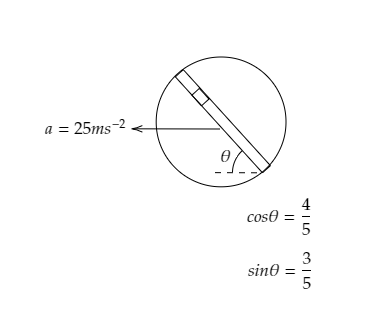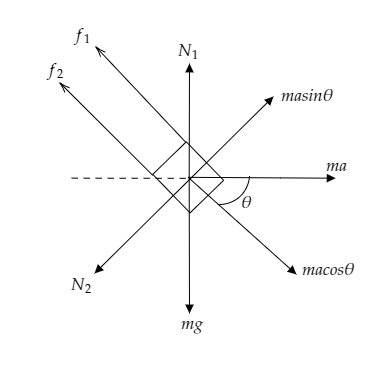Question
Question: A circular disc with a groove along its diameter is placed horizontally. A block of mass \(1{\text{k...
A circular disc with a groove along its diameter is placed horizontally. A block of mass 1kg is placed as shown. The coefficient of friction between the block and all the surfaces of the groove in contact is μ=52 . The disc has an acceleration of 25ms−2 . Find the acceleration of the block with respect to the disc.

Solution
Here as the disc moves to the left, the block inside the groove will move downwards and upwards causing the groove to turn and the angle θ changes accordingly. As the block slides, both of its sides are in contact with the surface of the groove which results in two frictional forces and two normal forces corresponding to each side. The pseudo force will make the angle θ with the horizontal direction and will be towards right as the disc moves towards left. Sketching a free body diagram of the system will provide a better understanding
Formulas used:
The frictional force acting on a body is given by, f=μN where μ is the coefficient of friction and N is the normal force acting on the body.
The force acting on a body is given by, F=ma where m is the mass of the body and a is its acceleration.
Complete step by step solution:
Step 1: Sketch a free body diagram of the given system. Also, list the given parameters.

The above figure is the free body diagram of the system involving a disc with a groove along its diameter onto which a block is placed.
The above figure depicts the direction of the forces in play.
The mass of the block is given to be m=1kg .
The coefficient of frictional force is given to be μ=52 and the acceleration of the disc is a=25ms−2 .
It is also given that cosθ=54 and sinθ=53 .
Let ab be the acceleration of the block which is to be determined.
Here the two frictional forces corresponding to the two points of contact are marked as f1 and f2 . The normal forces acting on either side of the block are marked as N1 and N2 .
The pseudo force acting on the block due to the acceleration of the disc to the right is given by F=ma and it makes the angle θ with the block. The cosine component and the sine component of the force are given as macosθ and masinθ .
The weight of the block W=mg is directed downwards.
Step 2: Express the force balance equation in all directions.
From the figure, we see that the weight of the body W=mg is balanced by the normal force N1 .
i.e., N1=mg --------- (1)
From the figure, we also see that the sine component of the force masinθ is balanced by the normal force N2 .
i.e., N2=masinθ ----------- (2)
As the block is directed along the cosine component of the force, the net force acting on the block can be expressed as macosθ−f1−f2=mab
Since the frictional forces can be expressed as f1=μN1 and f2=μN2 the above equation becomes macosθ−μN1−μN2=mab ---------- (3)
Substituting equations (1) and (2) in (3) we get, macosθ−μmg−μmasinθ=mab
⇒ab=acosθ−μg−μasinθ ------- (4)
Step 3: Substitute values in equation (4) to find the acceleration of the block.
Substituting for a=25ms−2 , μ=52, cosθ=54, sinθ=53 and g=10ms−2 in equation (4) we get, ab=(25×54)−(52×10)−(52×25×53)
Calculating this becomes ab=20−4−6=10ms−2.
Thus the acceleration of the block is ab=10ms−2.
Note: When the disc moves towards left with the given acceleration, the block will slide down and the angle θ will increase as the groove turns in the anticlockwise direction. The angle will increase until the groove turns to a maximum and will then decrease as the groove returns to its initial position. We consider the pseudo force because the block is in a non-inertial frame of reference.
